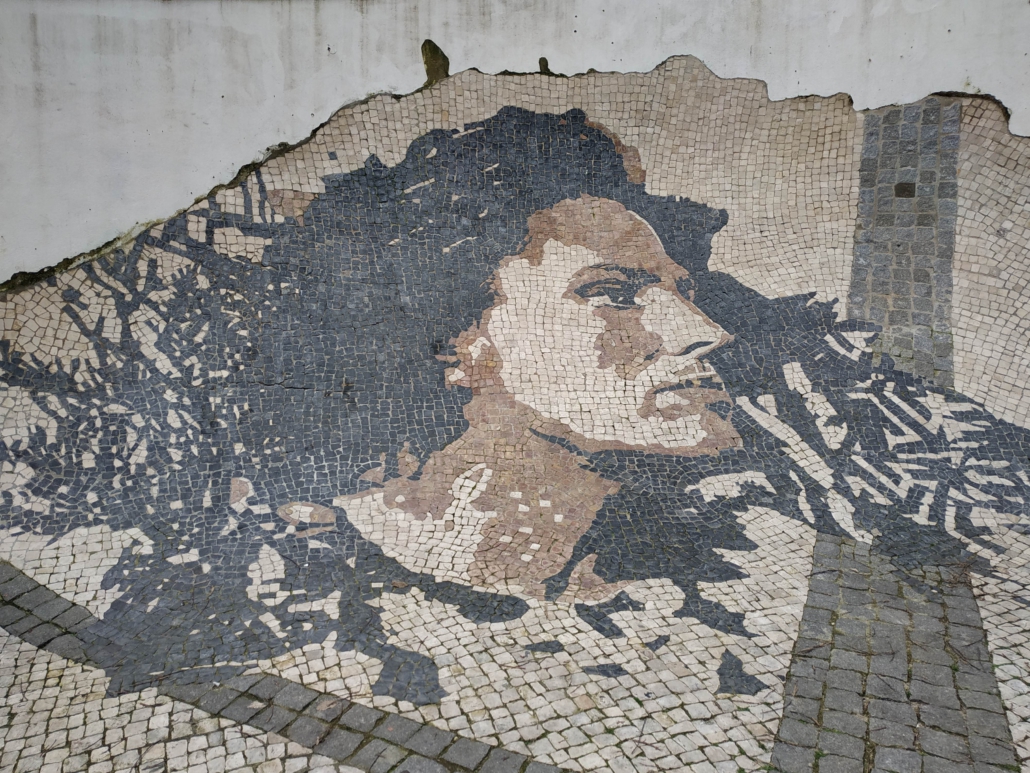Why self-driving cars should keep their eyes on the pavement: calçade portuguesa and pedestrian motion trajectories.
Calçade portuguesa – or Portuguese pavement – is a unique form of pavement found throughout Portugal. Though very beautiful, calçade portuguesa also impacts the behavior and motion trajectories of pedestrians. Understanding the pavement’s impact on pedestrians could help make self-driving cars safer.
Context
A critical aspect of building self-driving cars (SDCs) is predicting pedestrian behavior and motion trajectories. As human drivers, we take cues from pedestrians to help us navigate roads. For example, a pedestrian might be walking towards a crossing, which gives us the signal to stop our car.
SDCs similarly have to understand pedestrian cues. They can do this by modelling interaction and environment awareness. In this way, SDCs become aware of pedestrian behaviors and understand how to respond accordingly.
In this article, I suggest the impact of calçade portuguesa on the behavior of pedestrians requires more awareness from self-driving cars.
Calçada portuguesa
If you ever visited Lisbon, Portugal, you undoubtedly walked on Portuguese pavement, or calçada portuguesa (in portuguese). You find these charming traditional pavements all throughout the city.
You recognize calçada portuguesa by their small pieces of flat stones laid in mosaic-like patterns. While beautiful and giving the city a lot of character, these pavements also cause difficulties for those walking on them.
Issue #1: slipperiness
First, Portuguese pavement gets quite slippery as it rains. As people walk on them, the pavement wears down, resulting in very polished stones. These polished stones, combined with wetness of the rain, form the ideal conditions to slip. In the picture below, you can see the surface glistening after a rain shower.
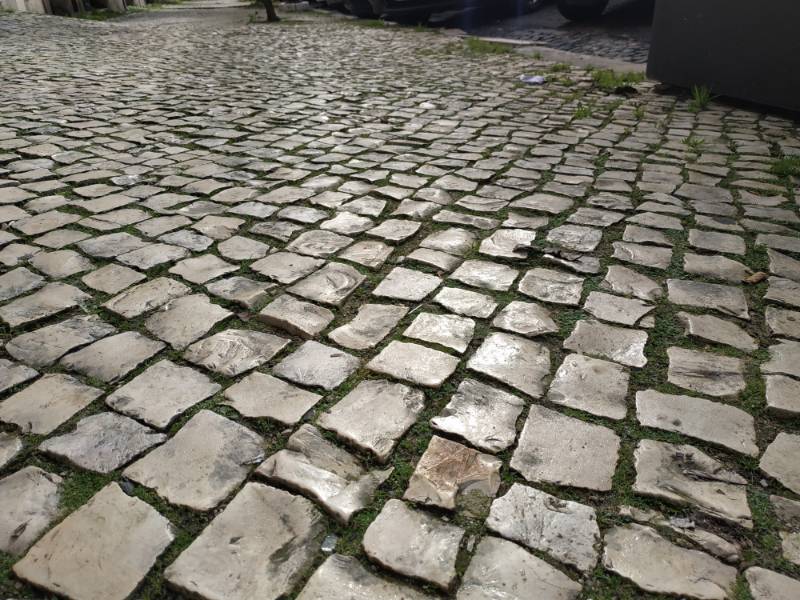
Issue #2: loose stones
Secondly, the pavement is also relatively hard to maintain. To make sure they are durable, the stones need to be laid by specialty pavers, specifically trained to lay calçade portuguesa. Unfortunately, there are not a lot of these craftsmen available anymore.
Consequently, with the huge surface area covered by the pavements, it is almost impossible to keep them up to date. As a result, stones come loose and, once that happens, it’s easy for other stones to follow suit until inevitably a hole has formed.

Issue #3: hills and narrow sidewalks
A third issue exacerbates the first two issues. Lisbon is a very hilly city, making slippery pavement and holes in them even more treacherous. What is more, because Lisbon is an old city, there are often a lot of roads with very narrow pavements because there’s no space for broader ones.
Adapting to calçada portuguesa
The above issues make walking in Lisbon an interesting experience. Guidebooks for first time visitors often tell people to prepare for the sidewalks and the steep hills by bringing fitting footwear such as sneakers.
Indeed, during a stroll throughout the city, seeing high heels – and even more so stiletto heels – is a rarity. In fact, one specific complaint surrounding calçade portuguesa comes from women who are practically unable to wear heels. Because of the slipperiness, unevenness, and holes, wearing heels becomes a dangerous endeavor.
As such, it’s interesting to see the rather unexpected styles of people’s shoes compared with their overall clothing. In the pictures below, for instance, senior people wear bright, flashy sneakers under their rather modest, daily clothes. Though not unique in and of itself, the prevalence of these contrasting styles is noteworthy.
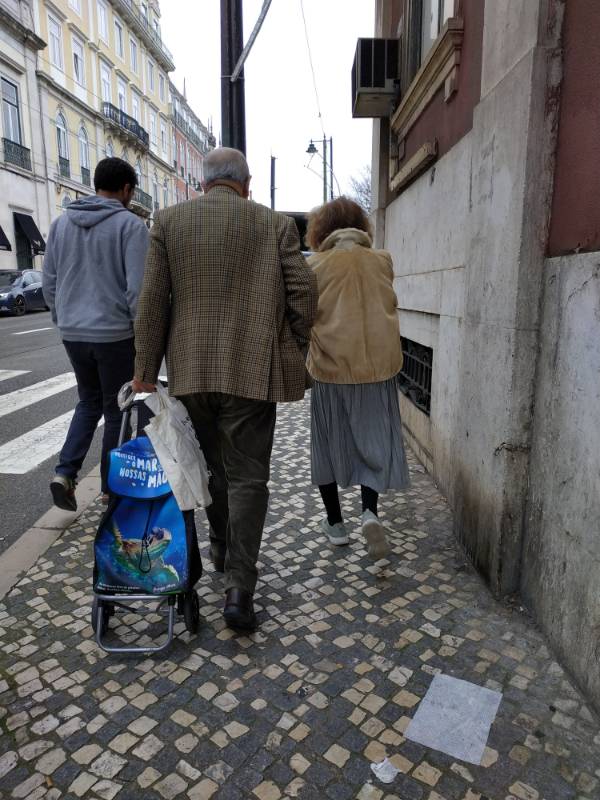
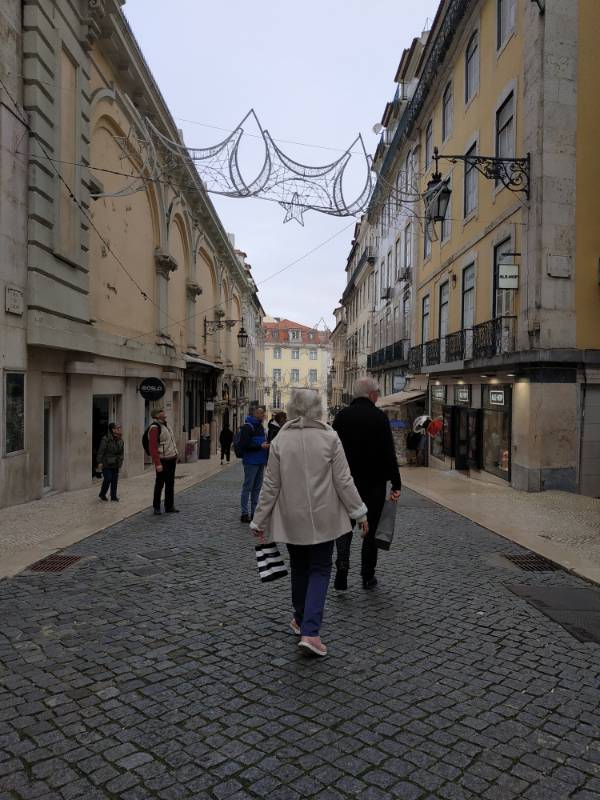
However – though fitting shoes help – the walk-ability of Lisbon’s sidewalks still forms a big topic of discussion within Lisbon. Many articles have been written about the danger of these pavements, including on how many people end up in the emergency room with injuries because of them.
Some Lisbon residents even have rules for walking on them, such as don’t walk on the pavement while drunk, don’t walk on the pavement and talk on your phone at the same time, and never pass a passerby on the right.
Below, I present three pedestrian behaviors that result from people adapting to the unique qualities of calçade portuguesa.
Changing pedestrian behavior
Tripping, sliding, and falling
As you can imagine, slippery and loose stones in the pavement form a hazard to pedestrians. It is so easy to trip, slide, and fall. In fact, in a public survey on the pavements, 55% of respondents noted they had already fallen on the pavement, while 92% expressed a fear of falling on the pavement.
In my own conversations with residents, the experiences noted in the survey were confirmed. For instance, one resident told me how she slipped on the pavement because of the rain, while another told me about her experience of tripping while unexpectedly stepping into a hole in the pavement. In both cases, these residents had only been living in Lisbon for less than 6 months.
Walking on the street
Because of the danger of slipping, it is not uncommon for people – especially senior people – to walk on the road instead of the sidewalks when it rains. For instance, the lady in the picture below walked for a rather long time on av. Duque de Loulé, a busy street where cars drive particularly fast.
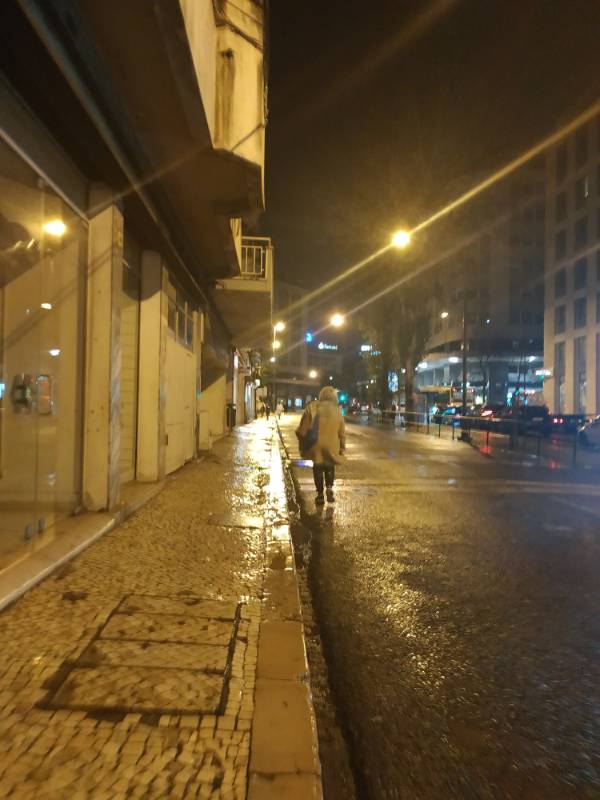
Of course, pedestrians walking on busy roads where sidewalks are available present unique challenges to drivers. For one, drivers have to pay extra attention in order to swerve around these pedestrians in time, as can be seen in the picture below.
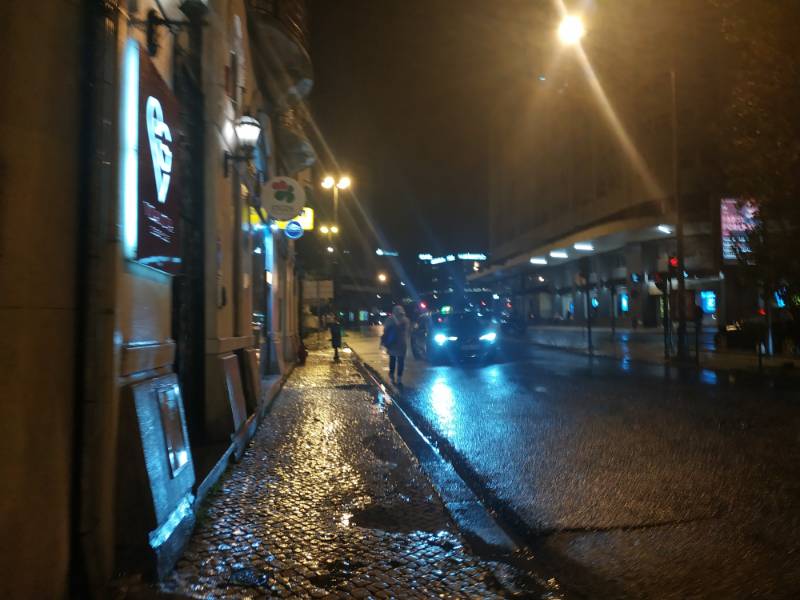
To exacerbate the problem, darkness and rain make pedestrians less visible (people casually walking usually don’t have high-visibility apparel like, say, joggers do). Furthermore, the expectation that pedestrians normally walk on the sidewalks, makes it even harder to prepare for them being on the street.
However, the state of the pavement isn’t the only reason why pedestrians walk on the street instead of the sidewalk. As some sidewalks are so narrow, people have to move onto the streets to pass one another, as can be seen in the picture below.
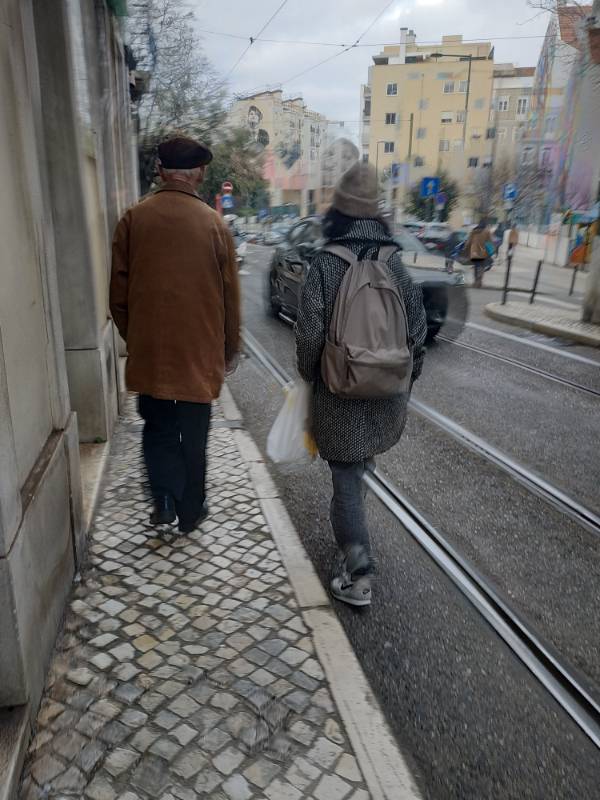
In this example, cars also have to swerve around passing pedestrians. What is more, streets with narrow pavements are often also narrow themselves. Add curvy and hilly streets, and drivers need to make swift, complex decisions to avoid colliding with passing pedestrians and oncoming cars.
Kicking loose stones
Finally – though likely less critical to drivers – people often kick loose stones laying on the sidewalks, either on purpose or by accident.
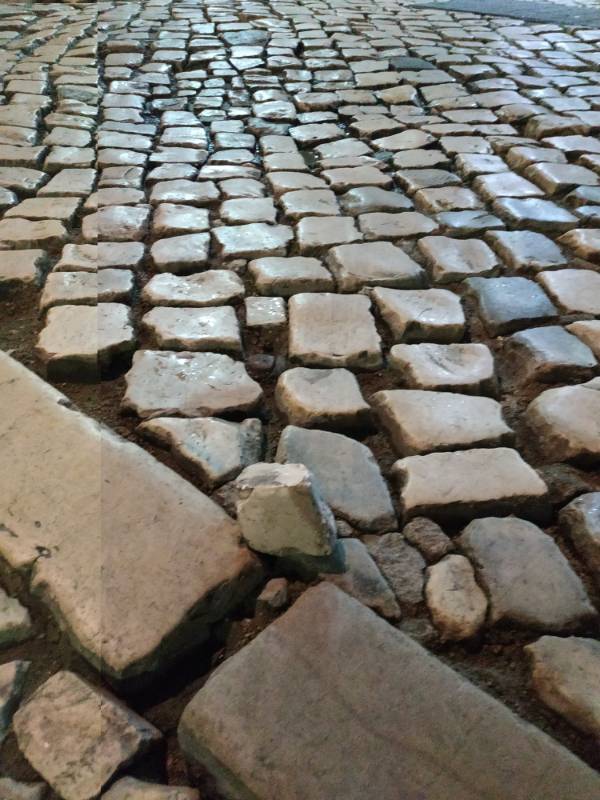
For instance, during my observations, one kid in a family of four started kicking a loose stone along while walking on the sidewalk. While his parents eventually told him to stop, stones can become a unpredictable projectiles. This was the case in another instance, where a loose stone hit an elderly man, though without much consequences.
Cultural heritage
Though these problems with the pavement exist and are widely known, simply replacing them with other types of pavement isn’t a solution.
Portuguese pavements form a part of Portuguese Heritage, and many people find them critical to the identity of Lisbon. What is more, these pavements contribute much more to the permeability of the soil, as rain can seep in between the stones.
The tension between the simultaneous beauty and danger of the pavements is, I feel, nowhere as clear as in the Olivais subway station on the red subway line (see picture below). This station’s platform is paved with Portuguese pavement, but the pavement is covered by a smooth, transparent layer to prevent tripping, slipping and falling onto the rails.
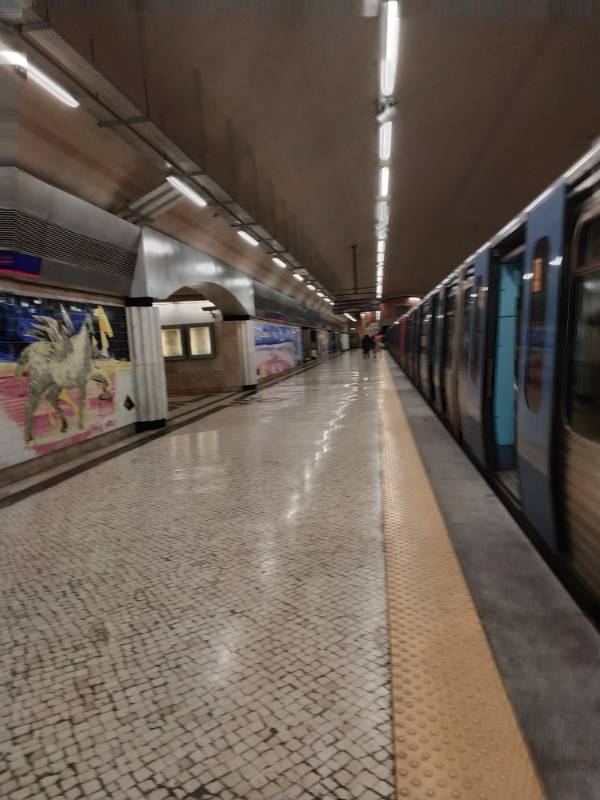
In other words, calçade portuguesa will likely remain an important part of Lisbon for the foreseeable future. Self-driving cars thus will have to be able to deal with them, as well as the behavior they elicit in pedestrians.
Recommendations for data scientists
The impact of calçade portuguesa might be easily missed when developing and testing self-driving cars. Holes in the pavement are certainly not everywhere, rain is rather rare in Lisbon during some seasons, and narrow sidewalks can’t be found everywhere. Direct observations of the above described behaviors are therefore rather unlikely, unless one looks for them.
What is more, pedestrian behaviors resulting in actual traffic accidents is often severely under-reported. This lack of official reporting, along with a lack of direct observations, might lead data scientists to not pick up on the issue.
Of course, the behaviors and their consequences are real. As such, it’s important to consider what impact the above issues and their resulting pedestrian behaviors mean for self-driving car systems.
1. Train models to distinguish between calçade portuguesa and other pavements.
State of the art semantic segmentation models trained on city images, such as Mask2Former, do not yet (understandably so) detect calçade portuguesa specifically. Nevertheless – considering the unique pedestrian behaviors described above – simply recognizing calçade portuguesa could already signal SDCs to drive more cautiously and to respond faster in dangerous scenario’s.
2. Expect pedestrians to walk on the road in unexpected places, especially when it rains.
Under normal circumstances, you would expect pedestrians in Lisbon to walk on the sidewalks. However, slippery and narrow sidewalks encourages some to walk on the road instead. Make sure that during rainy weather and in places with narrow sidewalks, the SDCs take extra precautions to detect pedestrians and correctly calculate their motion trajectories.
3. Understand there’s a higher chance of pedestrians tripping, slipping and falling.
Though pedestrians tripping, slipping and falling can always happen, there seems to be a higher likelihood of this happening in Lisbon. Prepare SDCs to understand these behaviors and adapt accordingly. Another option would be to detect holes in the pavement to detect high-risk areas early.

